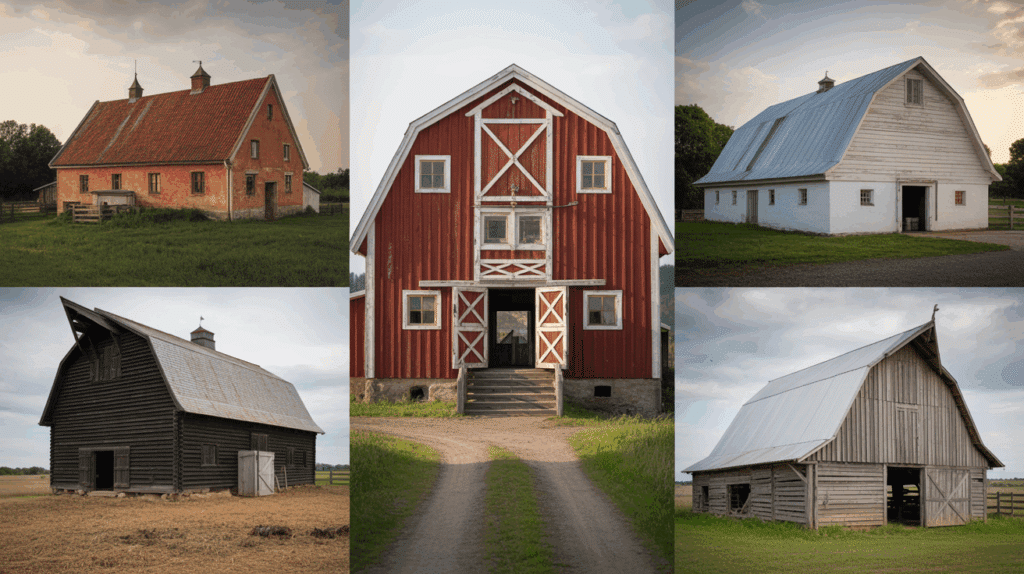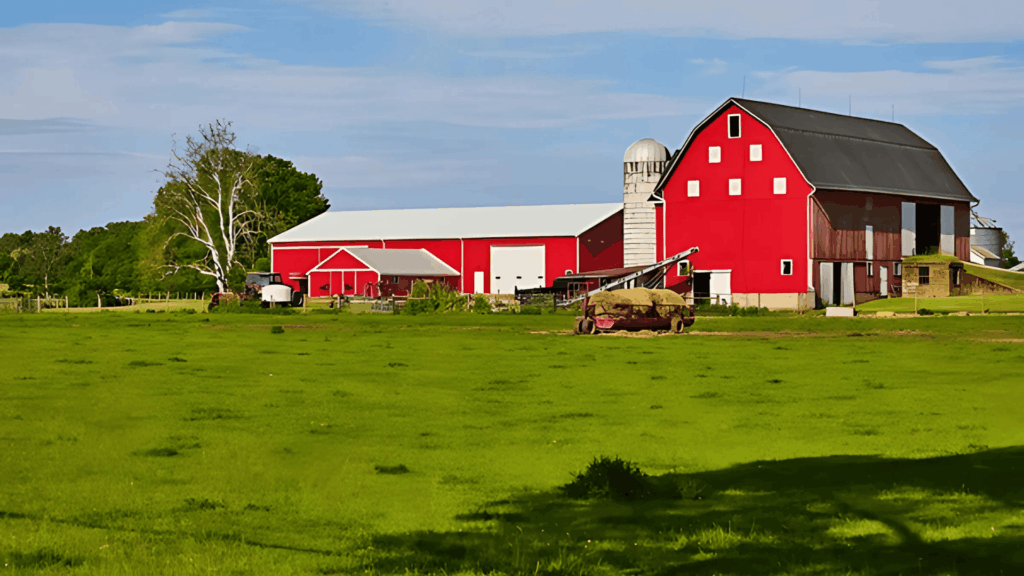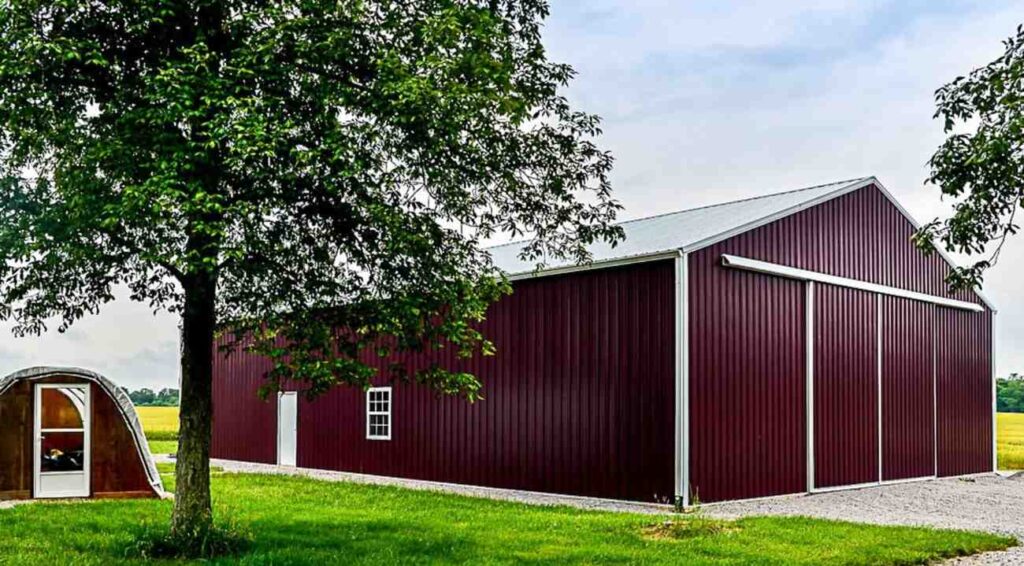I’ve always noticed how a red barn stands out when driving through the countryside. It feels warm and familiar, almost like a symbol of rural life. But have you ever stopped and asked yourself, Why are barns red instead of another color?
The answer isn’t just about looks; it’s tied to how farmers protected their barns, saved money, and followed traditions that carried on through time.
Here, I’ll share where the red color started, how it became common, and why many barns are still painted that way today. By the end, you’ll see the story behind a color that shaped farming history.
Why Are Barns Red?
Farmers in the 1700s and 1800s didn’t have hardware stores stocked with paint. They had to make their own mixtures to protect wood from harsh rain, wind, and snow.
The base ingredient was linseed oil, which comes from flaxseed. Farmers found it soaked well into wood, forming a layer of protection. To make it last longer, they added lime and milk. These helped the mixture stick and harden on barn walls.
The final touch was rust, easy to find on a farm and highly useful. Rust not only gave the mixture a red color but also prevented fungus and moss from growing on the wood.
This homemade sealant worked so well that it soon became common across farming communities. The rich, earthy red shade became a familiar sight. What began as a necessity eventually turned into a tradition.
Why Were Barns Painted Red Historically?
As time passed, store-bought paints became more available. Farmers still chose red, but now the reason was cost. Iron oxide, the mineral that creates the red pigment, is abundant in the earth. Because of that, red paint was one of the cheapest options.
A barn is a large building, and painting it requires a lot of material. Red paint allowed farmers to cover their barns without straining the budget. But the choice was not only about price.
Red paint made barns stand out during the long winters in northern states. Against snow-covered fields, the bright color was easier to see from a distance.
So red barns were both practical and economical. These two reasons cemented their place in American farming history.
Barns Global Parallels and Variations

The tradition of painting barns red isn’t limited to the United States. Around the world, farmers found creative ways to protect wooden buildings using local resources. While the shades and reasons varied, each region left its mark on the history of barn colors.
1. Sweden (1500s)
The Falun copper mine provided a pigment called Faluröd. Mixed with oil, it produced a deep red shade that farmers used widely. Many chose it because it gave their wooden farmhouses the look of costly brick buildings.
2. Other Parts of Europe
In several European regions, barns and farmhouses were painted in shades close to terracotta. These colors reflected both local styles and the natural materials available.
3. United States Variations
Barns in America didn’t all follow the red tradition. White barns became popular for dairy farms, giving them a clean, uniform appearance.
In Kentucky, black barns were used for drying tobacco since the darker color absorbed heat more effectively. Some barns were left unpainted, and over time, their wood weathered into a natural silver-gray; proof that not every farmer chose to rely on paint.
These differences remind us that while red barns are iconic, they were never the only choice.
Red Barns in Modern Farming and Culture

The meaning of the red barn has shifted over time. Today, it stands for more than its original purpose of protecting wood.
- Cultural Symbol: Red barns are now part of rural identity. They appear in logos, postcards, roadside art, and even as themes for restaurants and shops. Many people see them as a piece of American heritage.
- Tourism and Nostalgia: Travelers expect to see red barns when visiting the countryside. They’ve become popular backdrops for photos, weddings, and cultural festivals, making them part of the tourism economy.
- Modern Farm Choices: Some farmers paint barns white or other shades to match new steel or concrete buildings. Still, red remains the most recognized color.
- Heritage and Continuity: Even when not required, many farmers choose red because it ties their farms to history. The color carries forward a story that connects past generations with the present.
Why are Most Barns Painted Red Today?
Modern farmers can choose from thousands of paint colors. Even so, many still paint their barns red. The main reason is tradition. Families pass down farms for generations, and the red barn is a symbol of continuity.
Red barns also carry cultural meaning. They remind us of the past, when farming relied on resourcefulness and community.
People often choose red today not because it is necessary, but because it feels right. The color has become tied to the identity of rural America. And of course, red barns simply look striking. Many people keep the tradition alive for the visual appeal alone.
Can Barn Color Impact Property Value in the Present?
Barn color may seem like a small detail, but it can still influence how a property is viewed today. A red barn often adds charm and character, which can increase appeal for buyers or tourists looking for a traditional farm experience.
The familiar red makes properties stand out in photos and advertisements, boosting their attraction for events or agritourism.
On the other hand, neutral colors like gray, white, or natural metal may fit better with modern farms that focus on efficiency.
While color alone won’t drastically change property value, red barns can shape perception, making a farm feel welcoming, established, and tied to tradition, qualities that often leave a lasting impression.
The Rise of Metal Barns and the Fade of Tradition

Over time, many farmers began moving away from wooden barns and started using metal ones made from steel or aluminum. These materials were stronger, lasted longer, and required less upkeep.
Metal barns also cut costs for repairs and stood up better to the weather. As a result, the classic red wooden barn started to fade from everyday farming landscapes.
Still, red paint has not completely disappeared. Some farmers continue to paint their metal barns red, keeping the tradition alive as a nod to history and identity.
While modern barns focus on function and durability, the red color remains a symbol that connects farming today with its long-standing roots.
What Other Colors Were Used and Why?
Barns weren’t always red. Farmers used different colors based on cost, paint availability, and what they wanted their buildings to represent. Each color carried a meaning and gave the barn a certain character that reflected both function and tradition.
- White: Showed order and matched farmhouses.
- Green: Blended with fields and nature.
- Blue: Stood for hope or prosperity.
These choices were more than decoration. They connected the barn to the farm’s identity and values. While red became the most common and lasting, other colors reveal how farmers used paint not just for protection but also for expression and a sense of pride in their work
Final Thoughts
Now you know the real story behind why barns are red. It started with farmers protecting their wood, then it carried on because the paint was affordable and easy to see across fields. Over time, the color became a tradition that still feels right today.
When you notice a red barn on a quiet road, you can connect it back to the hands that built and cared for it. That color is more than paint; it’s a piece of history that continues across generations.
If you enjoyed learning about this, I’d love for you to check out more of my posts on the website for simple insights and practical ideas!














